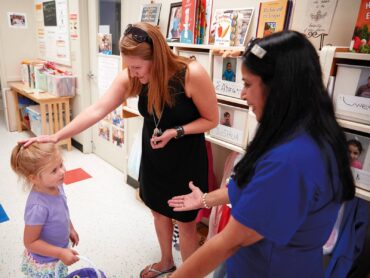 A new school year can feel like uncharted territory for children, parents, and teachers alike as they learn new things and meet unfamiliar faces. Building a relationship with your child’s teacher can help create a positive school experience for everyone involved. Plus, teachers who connect with their classroom families help families feel seen, heard, and represented in the classroom.
A new school year can feel like uncharted territory for children, parents, and teachers alike as they learn new things and meet unfamiliar faces. Building a relationship with your child’s teacher can help create a positive school experience for everyone involved. Plus, teachers who connect with their classroom families help families feel seen, heard, and represented in the classroom.
“When parents and teachers connect, they can create a stronger support system,” said Tyreca Elliott from KinderCare’s education team. “Bridging the gap between home and school gives children continuity, improves academic outcomes, and nurtures children’s social and emotional well-being. When families and teachers work together, children can succeed.”
Building connections with teachers opens lines of communication between home and school, allowing families to learn about their child’s day and helping teachers feel supported.
Consider these three tips from KinderCare teachers to help families create connections and build trust and collaboration with their child’s teacher.
Be Intentional.
Ruby Villarreal, a preschool teacher of nearly 30 years, suggests meeting with your child’s teacher before the first day of school, if possible, to introduce your child and your family. Share your child’s previous school experience, likes and dislikes as well as any home issues that may impact your child’s mood or behavior, such as a new sibling, recent move, or divorce. Raise any concerns you may have — no matter how big or small. Your child is the teacher’s priority too, and he or she might have some tips and tricks to help you help your child.
Communicate about Communications.
Drop-off and pickup times can sometimes be too busy for more than a “hi” or “bye.” Ask your child’s teacher how he or she likes to communicate and share your preference, too. Let the teacher know if you would like a phone call during a lunch break for a quick update about your child or if you’d rather communicate via email or the school’s app.
Make a Big Difference with Little Chats.
During pickup or drop-off, try to leave time for a brief conversation. This could be a quick chat about something fun your child did over the weekend or why he or she might be having a tough day. It could also mean asking, “What can I ask my child about on the way home?” or finding out about activities you could do to help your child keep learning at home.
“Learning is a partnership between families and school,” said Quiana Smith, a 15-year prekindergarten teacher. “Your child will be excited about school and learning when he or she knows you’re excited about it, too.”
To learn more about how to create connections between home and school, visit kindercare.com.























